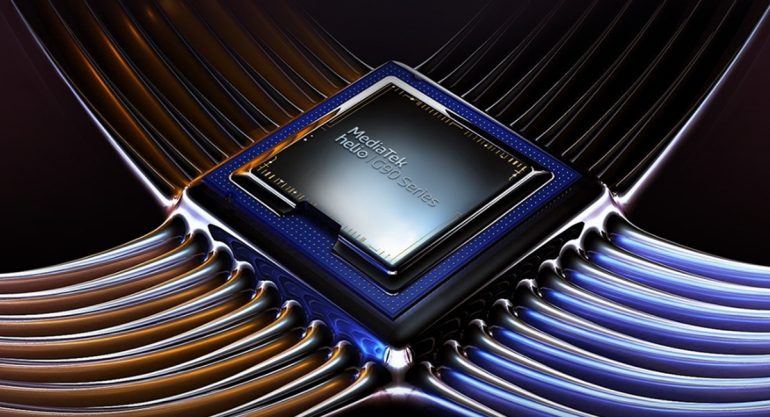
On the machine inferencing side, MediaTek makes a big jump in terms of computational performance: Here we still see continued use of Tensilica’s DSP in the P90, the unit that was able to also handle machine learning inferencing workloads on the P60 and P70. To put this into perspective, this is roughly over double the fillrate of the P60’s Mali G72MP3 GPU and represents either a 77% increase in FMADD throughput, or an 18% increase in FLOPS/clock depending on if you also count FADD units. This is Imagination’s biggest 9XM configuration and comes with 2 USCs for a fillrate throughput of 8 pixels per clock as well as a total compute throughput of 128 FLOPS/clock. On the GPU side, we see a big shift for MediaTek as for the first time in a long time we see the company putting aside Arm Mali GPU in favour of Imaginations new PowerVR GM 9446 GPU running at up to 970 MHz. MediaTek talks about including a “large 元” in the new chipset, however doesn’t disclose its exact size, neither talks about the L2 configurations of the CPU cores. In terms of multi-threaded performance this should represent a downgrade over the P60/70, even though the new A75 cores should represent a good boost over the A73 cores.

What is very surprising here for MediaTek is the core-count for each core type: MediaTek has moved on from a 4+4 configuration to a 2+6 configuration, mimicking Qualcomm’s Snapdragon 670 and 710 chips. The A75 cores are clocked in at 2.2GHz, while the A55 cores come at a similar 2.0GHz clock as its predecessors. The Arm Cortex A73 and A53 cores of the P60 and P70 have been replaced by the newer generation Cortex A75 and Cortex A55 cores. Let’s start on the specifications of the P90: MediaTek Current P-SeriesĪt the heart, the new P90 is now MediaTek’s first Arm DynamIQ CPU configured SoC. The P90 naming seemingly positions the chipset at the very high-end of the “P-series”, yet its specifications aren’t exactly matching this positioning. Today’s announcement is about the new Helio P90: The new chipset is quite a surprise as it isn’t exactly what I had expected. With new generation manufacturing processes around the corner, as well as Arm’s new Cortex IP cores, I’ve been expecting a new release from MediaTek for a while now. The P70 released later this year seemingly was the same P60 chipset binned at a higher clock-speed. The quad-core CPU is manufactured on Intel's second-gen 10 nm process marketed as SuperFin for decent, as of mid-2022, energy efficiency.It’s been a while since we’ve talked about MediaTek – the Helio P60 was the last release in the more visible “premium” range that the company now focuses on. Either way, that's a tad too high to allow for passively cooled designs. This little Core i7 here has a default TDP of 12 W to 28 W, the expectation being that laptop manufacturers will go for a higher value in exchange for higher performance. While the i7 is not Intel's fastest laptop-grade processor by any stretch of imagination, it's more than usable for your productivity and creative apps, with a bit of gaming possible as well. The average 1185G7 in our database is just as fast as AMD's hexa-core Ryzen 5 4500U APU is, as far as multi-thread performance is concerned. The GPU and CPU can together use the 12 MB of 元 cache.įurthermore, Tiger Lake SoCs add PCIe 4 support (four lanes), AI hardware acceleration, and the partial integration of Thunderbolt 4/USB 4 and Wi-Fi 6 in the chip. In the i7-1185G7 it uses 96 EUs and clocks between 400 - 1,350 MHz.
Helio p70 vs p60 vs p60 with apu plus#
It should offer a significantly higher performance compared to the older Iris Plus G7 (Ice Lake).

Since early 2021, the i7-1185G7 supports management features like vPro.Īnother novelty is the integrated Iris Xe iGPU based on the completely new Gen 12 architecture.

At the time of announcement, the i7-1185G7 is the fastest model of the line-up. All cores at once can clock at up to 4.3 GHz. Each core can clock from 1.2 GHz (12 W base clock speed), 3 GHz (28 W base clock speed) to 4.8 GHz (single-core boost). It integrates four Willow Cove processor cores (8 threads thanks to Hyper-Threading). The Intel Core i7-1185G7 is a power-efficient quad-core SoC for laptops and Ultrabooks based on the Tiger Lake-U generation (UP3) that was introduced September 2020. Intel Core i7-1185G7 ► remove from comparison


 0 kommentar(er)
0 kommentar(er)
